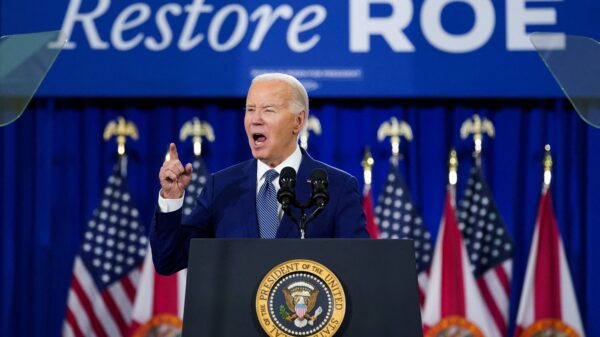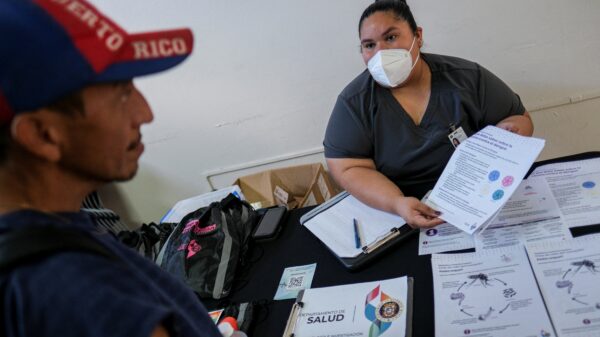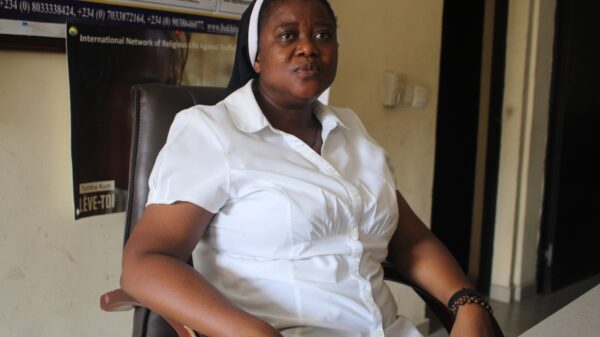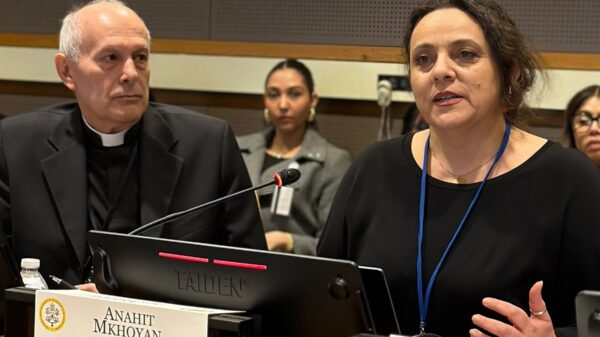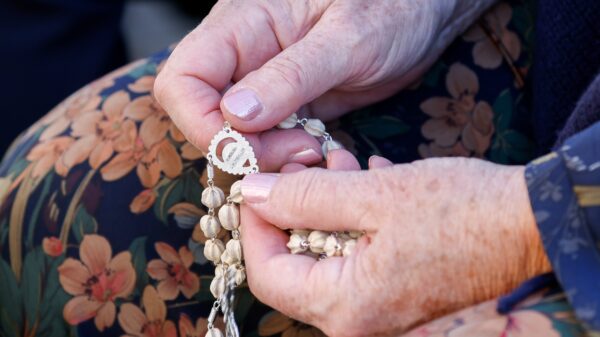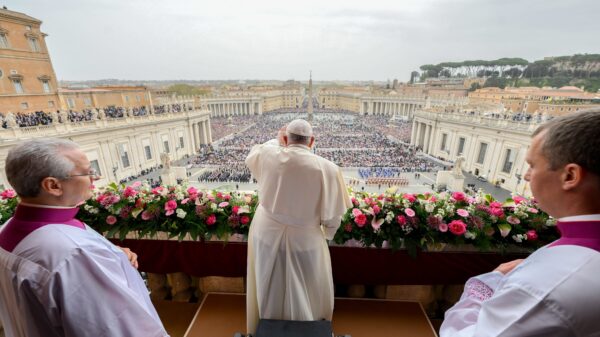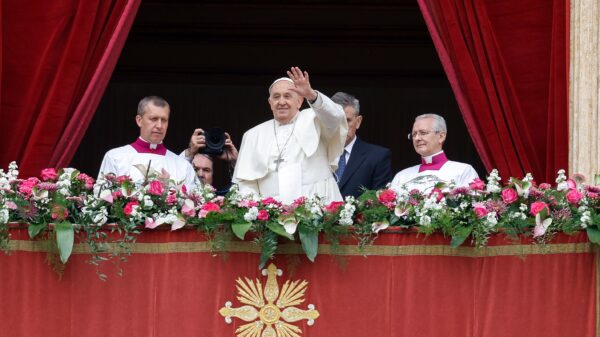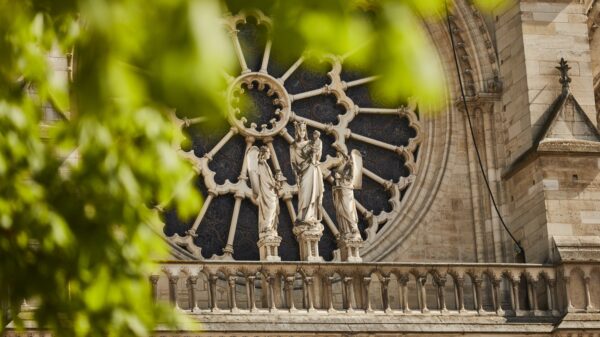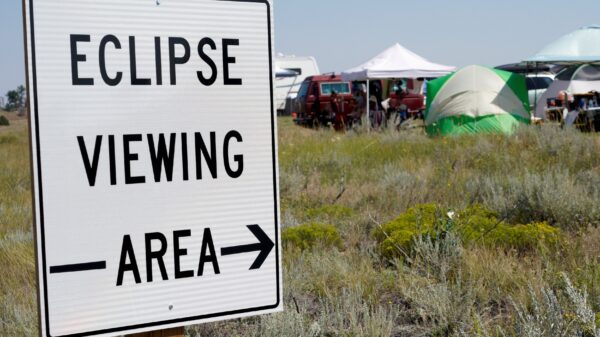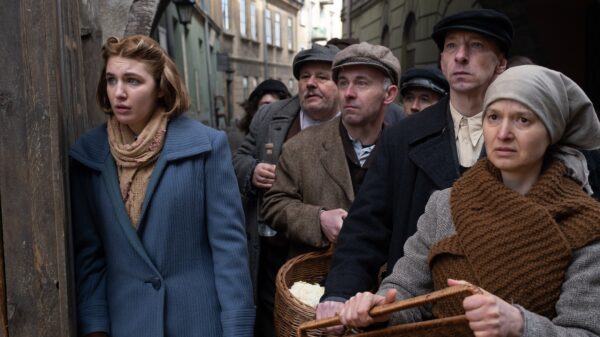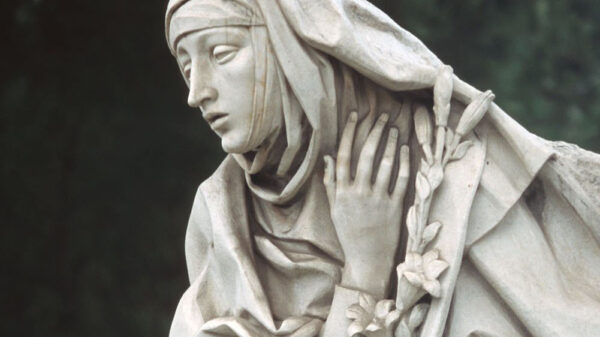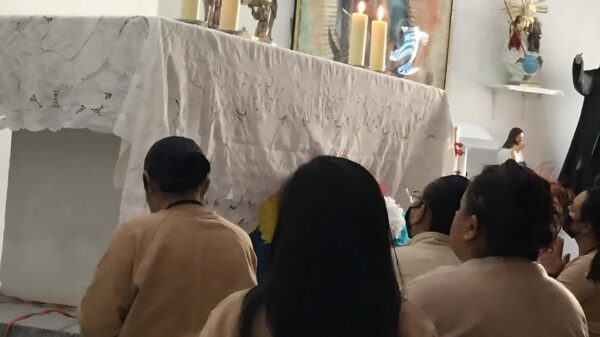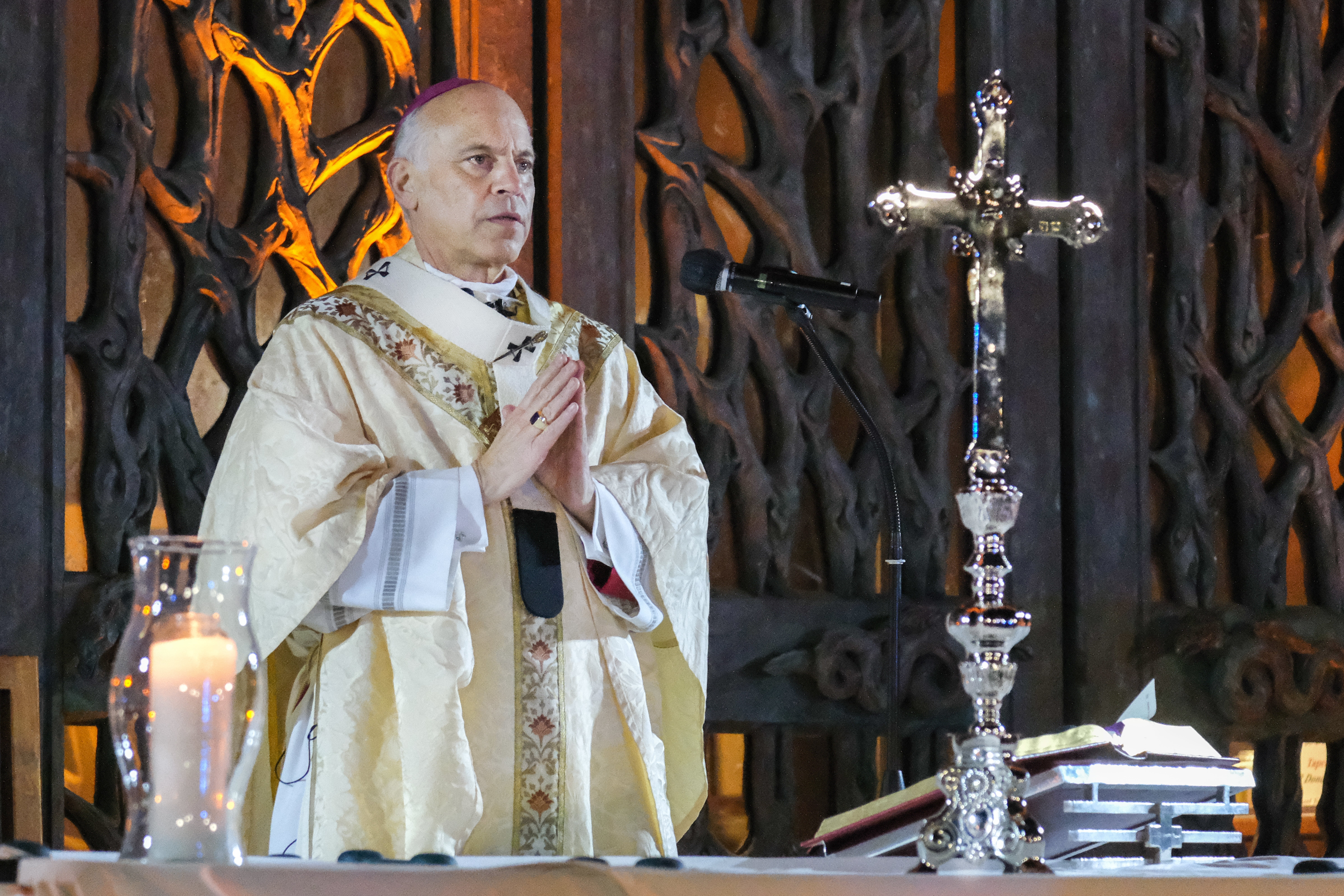ST. PAUL, Minn. (OSV News) — In March 2017, Will Peterson and his friend David Cable stepped out Peterson’s front door in Lexington, Kentucky, to begin a pilgrimage. Their destination was the Trappist Abbey of Gethsemani, some 70 miles away.
The journey is 75 minutes by car along the Bluegrass Parkway, but the friends didn’t drive. Instead, with backpacks and hiking books, they walked the route, in rain and shine, relying on strangers’ hospitality along the way.
The experience led to Peterson and Cable in 2019 co-founding Modern Catholic Pilgrim, a Twin Cities-based nonprofit organizing the National Eucharistic Pilgrimage that begins mid-May. Four groups of pilgrims will travel — mostly by foot — from routes beginning in the north, south, east and west of the country, converging in Indianapolis ahead of the National Eucharistic Congress July 17-21.
The pilgrims will accompany a monstrance displaying the Eucharist the entire way, making their walk somewhat of an eight-week Eucharistic procession through mountains, plains, cities and countryside.
The undertaking is massive, but Peterson — Modern Catholic Pilgrim’s president — said he is working with pilgrimage coordinators in the 65 dioceses the pilgrims will pass through to secure their housing and meals, and to plan special events such as Mass and adoration wherever they stay.
Each route has been locally mapped out and traveled to ensure there are no unexpected obstacles, such as freeway walls or road construction. Local coordinators also are, when needed, working with local authorities to make large-scale processions possible. While smaller events are planned nightly, each weekend of the pilgrimage places the pilgrims in a city, where Mass, adoration and other celebrations are planned.
In Minnesota, the Archdiocese of St. Paul and Minneapolis, where Peterson now lives with his wife and son, is marking the pilgrims’ weekend in the Twin Cities May 24 with a 5-mile procession from the University of St. Thomas — coincidently home to Modern Catholic Pilgrim’s office — down a historic avenue to the Cathedral of St. Paul, also designated the National Shrine of the Apostle Paul.
Part of the three-year National Eucharistic Revival underway, the National Eucharistic Pilgrimage is by far the largest project Peterson and his small team have worked on. The central focus is small pilgrimages — sometimes mere city blocks — that focus on local religious sites, such parish churches.
Modern Catholic Pilgrim also organizes pilgrimages to established U.S. shrines that commemorate the country’s saints including St. Elizabeth Ann Seton, St. John Neumann and St. Junípero Serra, as well as places that honor the men and women who have saint causes underway, such as Father Augustus Tolton.
Peterson, 31, knows firsthand the power of a pilgrimage. A native of San Diego, Peterson spent Holy Week 2013 in Rome on a pilgrimage organized by the University of Notre Dame, where he was then an undergraduate. He experienced the tradition of Eucharistic adoration in seven churches on Holy Thursday night, prayed with newly elected Pope Francis at the Colosseum on Good Friday and attended Easter Mass at the Vatican.
“That was really where I encountered the Holy Spirit in a major way,” Peterson said. He is a cradle Catholic, he said, but his Catholicism felt like a cultural expression, not true faith. That changed in Rome.
Despite the week’s late nights and early mornings, “stepping out in the streets of Rome for that Easter Sunday was like lightning coming from my fingertips,” he said.
That energy continued after the trip, as he dove into writings by and about the saints and other influential Catholics, including Catholic Worker movement co-founder Dorothy Day and Gethsemani Trappist monk Father Thomas Merton, who wrote about the idea of what Peterson thinks of as “biblical hospitality,” in which Christians care for each other, including opening their homes for those needing a place to stay.
Peterson connected those ideas to previous “proto-pilgrimages” he had done, like the time he took a train from Chicago to Ottumwa, Iowa, where he spent a weekend, sleeping one night under a tree and the next at the parish church. He planned a similar trip to Rugby, North Dakota, surprising a parish priest with his request for a place to stay. Once the priest understood Peterson’s purpose, he offered a room in the rectory.
“Merton talks about how we’re all naturally wanderers and wayfarers,” Peterson said. Those trips, he acknowledged, were means of testing out whether biblical hospitality does — or can — exist in the contemporary U.S. Catholic Church. “I was glad to find it there,” he said.
While many Catholics associate pilgrimage with trips to Jerusalem, Lourdes, France, or Rome, Peterson hopes Modern Catholic Pilgrim can simplify the idea and act of pilgrimage. With a prayerful disposition and intention, even a walk to watch the sunset and marvel at God’s majesty could be a pilgrimage, he said.
This spring, Modern Catholic Pilgrim events include a weeklong pilgrimage from New York City to the National Shrine of St. Rita of Cascia in Philadelphia; a 3-mile walk between two St. Paul, Minnesota, parishes to honor St. Joseph’s feast day; and a daylong pilgrimage from the U.S.-Mexico border to Sacred Heart Church in Coronado, California, culminating in a Palm Sunday vigil Mass.
Last June, Peterson tested some aspects of the National Eucharistic Pilgrimage in Indiana on a eight-day, 100-mile pilgrimage between the co-cathedrals in Fort Wayne and South Bend. As the group walked with the monstrance through Mishawaka, a little girl who had just received her first Communion that spring spotted the pilgrims, ran into her room, put on her white dress, and joined the procession for a couple of blocks, taking the priest-chaplain’s hand.
“It’s knowing those moments and what is possible, I’m grateful for that,” Peterson said. “I think that’s going to be life changing, especially for the (National Eucharistic Pilgrimage’s) perpetual pilgrims, the young adults who will be walking the whole thing.”
Walking pilgrimages have a long tradition in Europe and the Holy Land. One of the best known is the Way of St. James, a network of pilgrimage routes that lead to the Cathedral of Santiago de Compostela, Spain, where St. James the Apostle is buried. While Peterson hopes to someday undertake the Camino himself, he realizes those historical pilgrimages are out of reach for many U.S. Catholics.
“For the rest of us,” he asked, “why not take part in this wonderful tradition? … Let’s highlight these sites in the United States that you can make a pilgrimage to; let’s create that biblical hospitality connection where you’ve got people who have that prayer charism of hospitality … and then let’s have young people experience that hospitality.”
Pilgrimage particularly appeals to young adults, including those who are spiritually seeking, Peterson said. Like hiking the Appalachian Trail, pilgrimages are challenging, have a low barrier to entry, few requirements beyond walking, and are open to people anywhere on their spiritual journey.
Young people want direction, purpose and authenticity, Peterson said. If someone says they find God in nature, “awesome,” he said. “Let’s go in nature, but let’s do it in this tradition. … Let’s have a very purposeful form of travel.”
It rained the first day of Peterson’s 2017 pilgrimage from Lexington, Kentucky, to the Abbey of Gethsemani, but Peterson and Cable made it 20 miles, praying rosaries and reciting psalms along the way. Peterson had called ahead to parishes to ask for overnight hosts, and they spent their first night cheering on the Kentucky Wildcats in March Madness with a middle-aged Catholic couple.
“It was just beautiful — we just had a great meal, talked, learned about their family. They gave us a place to shower, a place to sleep. And then they sent us off the next morning,” he said.
The next night their host took them out for pizza and talked about the Civil War history of his home. The third afternoon they outran a storm, seeking shelter in a State Farm Insurance office until they could connect with that night’s hosts.
“At State Farm, they’re like, ‘Those guys are crazy,'” he recalled with a laugh. But by the time they left, the people there had offered rides and a place to stay if needed. For Peterson, that connection is the point of a walking pilgrimage that relies on hospitality.
“In order to give hospitality, we need to learn to receive it,” he said. “We get to see how people are just living the faith. There’s that mutual reliance on others — having to rely on others and what that means, because we’re called to that as Christians, but our society doesn’t like that. We’re supposed to be ‘self-reliant.'”
As the pilgrims approached the abbey on day four, they happened to be finishing Psalm 121. Bells were summoning the monks to midday prayer, so the friends dropped their packs and headed to the chapel. They walked in to hear the monks praying Psalm 122.
“That is the pilgrim’s prayer for Jerusalem,” Peterson said. “That is what Jesus himself (was) saying when he got to Jerusalem for Passover.” He was amazed at the coincidence, which he took as confirmation from God that he was where he was supposed to be at that moment.
The most powerful parts of pilgrimage are those Modern Catholic Pilgrim can’t plan: how the Holy Spirit works in pilgrims’ lives.
“It is so remarkable to slow down to encounter God at 3 miles an hour, and to make it so simple,” Peterson said. “Pilgrimages are simple, but not simplistic. What it all really boils down to is where are you going, and what are your intentions when you get there? You don’t need a PhD. You don’t need a theology background. … Any of us can do that, and trust that God answers and responds.”
Maria Wiering is senior writer for OSV News.


